Outline of TCFD Response
Climate change is a global challenge for all countries and regions, and the reduction of greenhouse gases is a global long-term target. The Nisshinbo Group believes that it is crucial to incorporate business opportunities caused by climate change and appropriately respond to risks. Accordingly, in FY2021 the Group began analyzing climate change scenarios in accordance with the recommendations of the Task Force on Climate-related Financial Disclosure (TCFD). In June 2022, the company expressed its agreement to the TCFD recommendations.
Through climate change scenario analyses, the Group will identify the risks and opportunities that climate change may pose to the business in future, develop more flexible and robust strategies by leveraging the opportunities in the development of business strategies, and increase the resilience against future risks.
TCFD Disclosure Item
Governance
As shown in the diagram below, the Nisshinbo Group established and operates a framework for appropriately responding to risks and opportunities related to climate change. In order to make risk an opportunity for sustainable growth, the Group will constantly identify and analyze changes in the various business environments. Based on the business policies derived from the Group's corporate philosophy, the Nisshinbo Group will create new growth opportunities by contributing to society through business activities. Responsibilities for climate-related issues are borne by such meetings as the Board of Management, which is composed of the president and executive officers, and reports to the Board of Directors. The Board of Directors discusses responses to the reported climate-related issues and oversees goals and the progress made.
Governance Structure
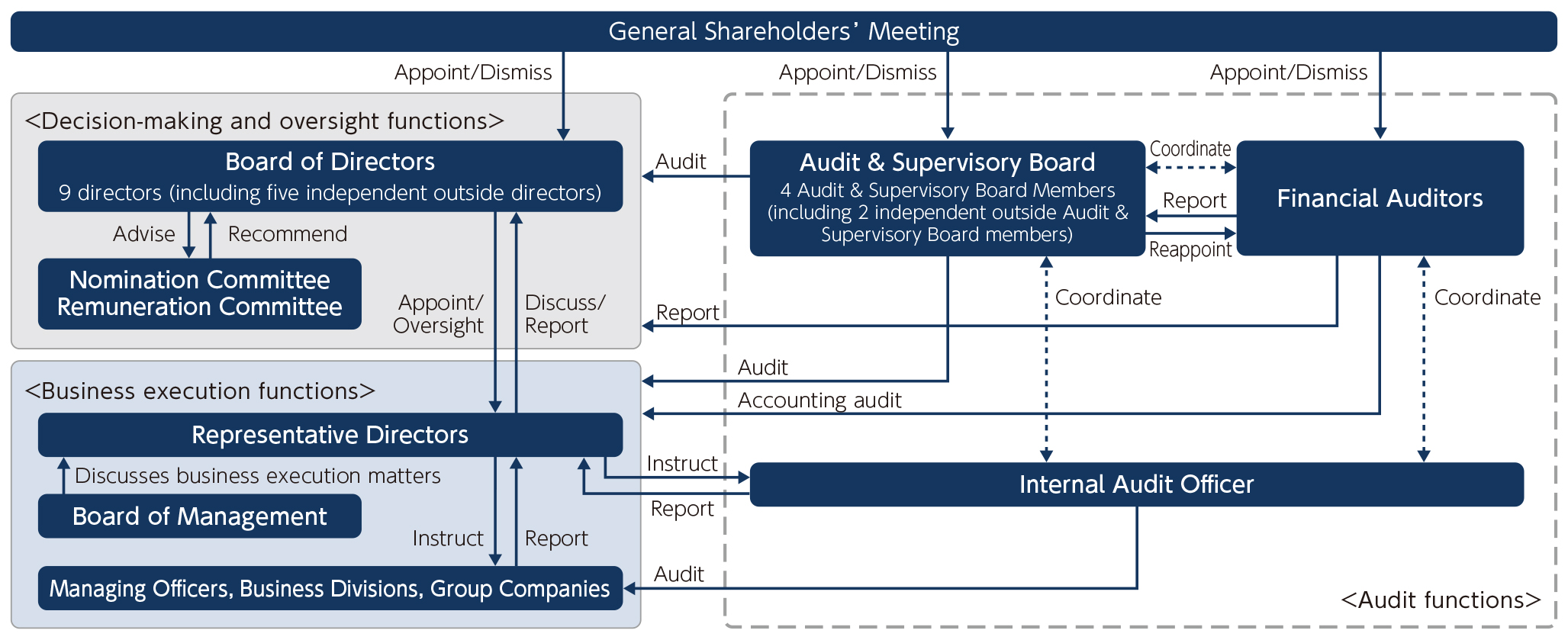
Strategy
An Overview
Since the Nisshinbo Group has a wide range of businesses, a climate change scenario analysis was conducted in stages starting in FY2021, and an analysis of the Group's major businesses was completed* in FY2023. In FY2021, the Group targeted the Solutions business in the Wireless and Communications business, the Automobile Brakes business, and the Chemicals business that are expected to have a large risk/opportunity impact. In FY2022, the analysis was conducted in major businesses with production activities by covering the Marine System, ICT/Mechatronics, and Mobility business in the Wireless and Communications business, the Micro Devices business, the Precision Instruments business, and the Textiles business. For FY2023, the scope of the program includes Medical Equipment business in the Wireless and Communications business, Real Estate business, and Other businesses, as well as initiatives in the Business Development Division. The climate change scenarios used are for a world where warming progresses (warming progression scenario, 2.5°C to 4°C) and a world where warming is controlled and active transitions occur (decarbonization scenario, 1.5°C to 2°C).
* Excluding KOKUSAI DENKI Electric Inc., which became a subsidiary in December 2023.
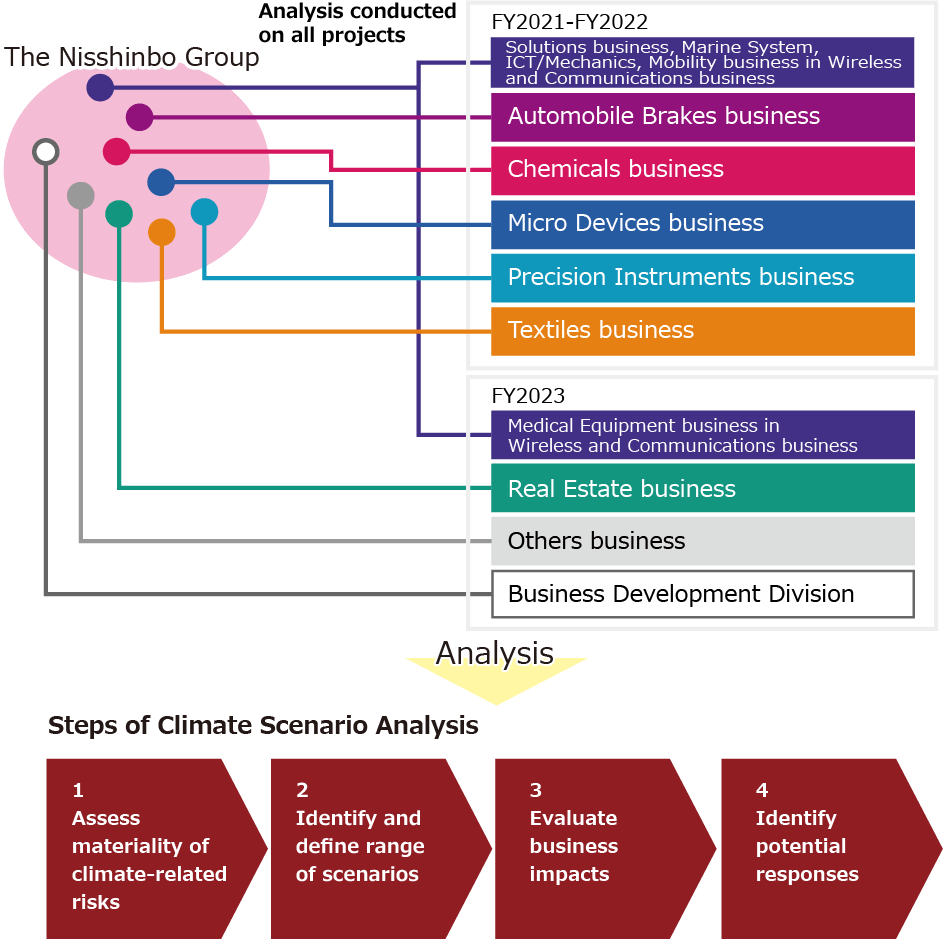
1. Assess Materiality of Climate-related Risks
As the first step in the scenario-analysis, the Nisshinbo Group identified the material risks and opportunities for each of the targeted businesses with reference to the external literature related to TCFD Final Report and industries. Because the impacts of climate change have the potential to materialize over the medium to long term, the Group qualitatively assessed the risks and opportunities on a large, medium, and small basis, not only in the short term but also over the medium to long-term time horizon up to 2050. As a consequence, the following table shows the significant risks and opportunities associated with business continuity and the creation of new businesses.
|
|
|
|
|
|
|
|
|
|
|
|
||
|
|
|
|
|
|
|
|
|
|
|
|
|
|
|
| Risk Type | Assessment Item | Risks | Opportunities | |
|---|---|---|---|---|
| Category | ||||
| Transition Risks | Policy and Legal | Carbon price |
|
|
| Market and Technology Shifts | Energy mix |
|
- | |
| Customer and market changes |
|
|
||
| Spread of low-carbon and energy-saving technologies |
|
|
||
| Physical Risks | Chronic | Average temperature rise, and change in precipitation and weather patterns |
|
|
| Acute | Severity of extreme weather events |
|
- | |
2. Identify and Define Range of Scenarios
The Nisshinbo Group analyzed climate-related risks and opportunities under the warming progression and decarbonization scenarios using 2050 years as the time axis. For the analysis, see the following literature.
| International Energy Agency (IEA) | Intergovernmental Panel on Climate Change(IPCC) |
|
|---|---|---|
| Warming Progression Scenario | ・Stated Policies Scenario (STEPS) ・Reference Technology Scenario (RTS) |
・RCP8.5 |
| Decarbonization Scenario | ・Net-Zero Emissions Scenario (NZE) ・Sustainable Development Scenario (SDS) |
・RCP2.6 or RCP4.5 |
* IEA scenarios, etc. are based on the latest data available at the time of analysis of each project, and there may be slight differences in conditions and other factors.
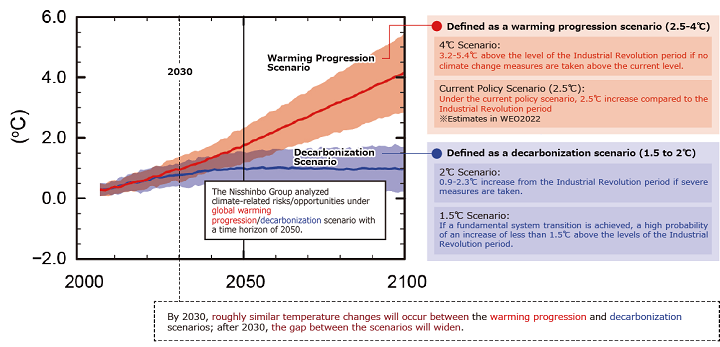
* Prepared by Nisshinbo Holdings Inc. from the IPCC Fifth Assessment Report
The Nisshinbo Group organized the global view of the warming progression scenario and the decarbonization scenario.
In the warming progressive scenario, while some sites will be affected by flooding and other damage, sales opportunities for countermeasure products and services as temperatures rise will increase, and demand for disaster prevention-related products and services is expected to rise.
In the decarbonization scenario, countries will tighten emission reduction targets and introduce high carbon taxes, while demand for decarbonization-related products and environmentally friendly products, especially EVs/renewable energy, is expected to increase. Each image looks like the following:
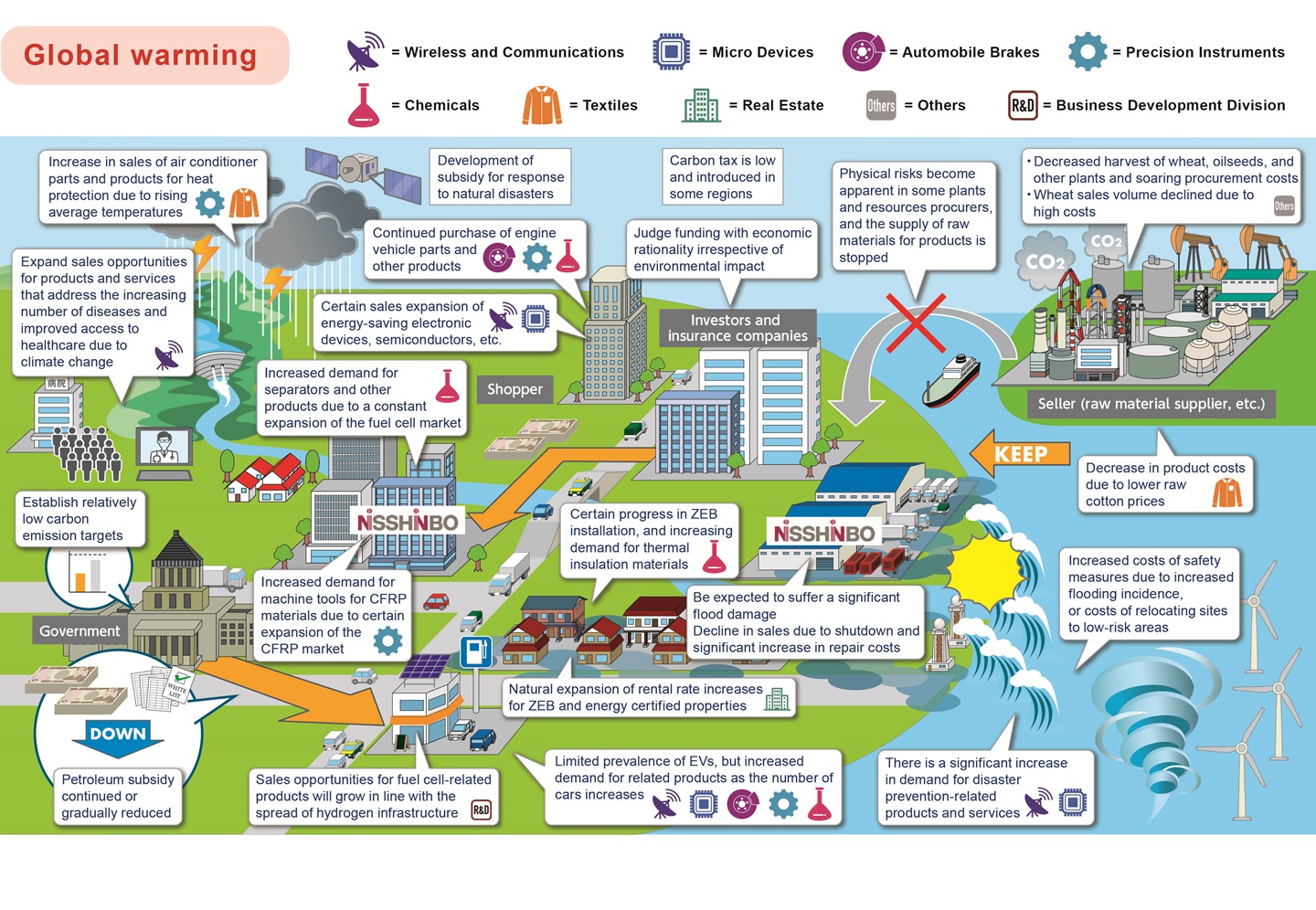
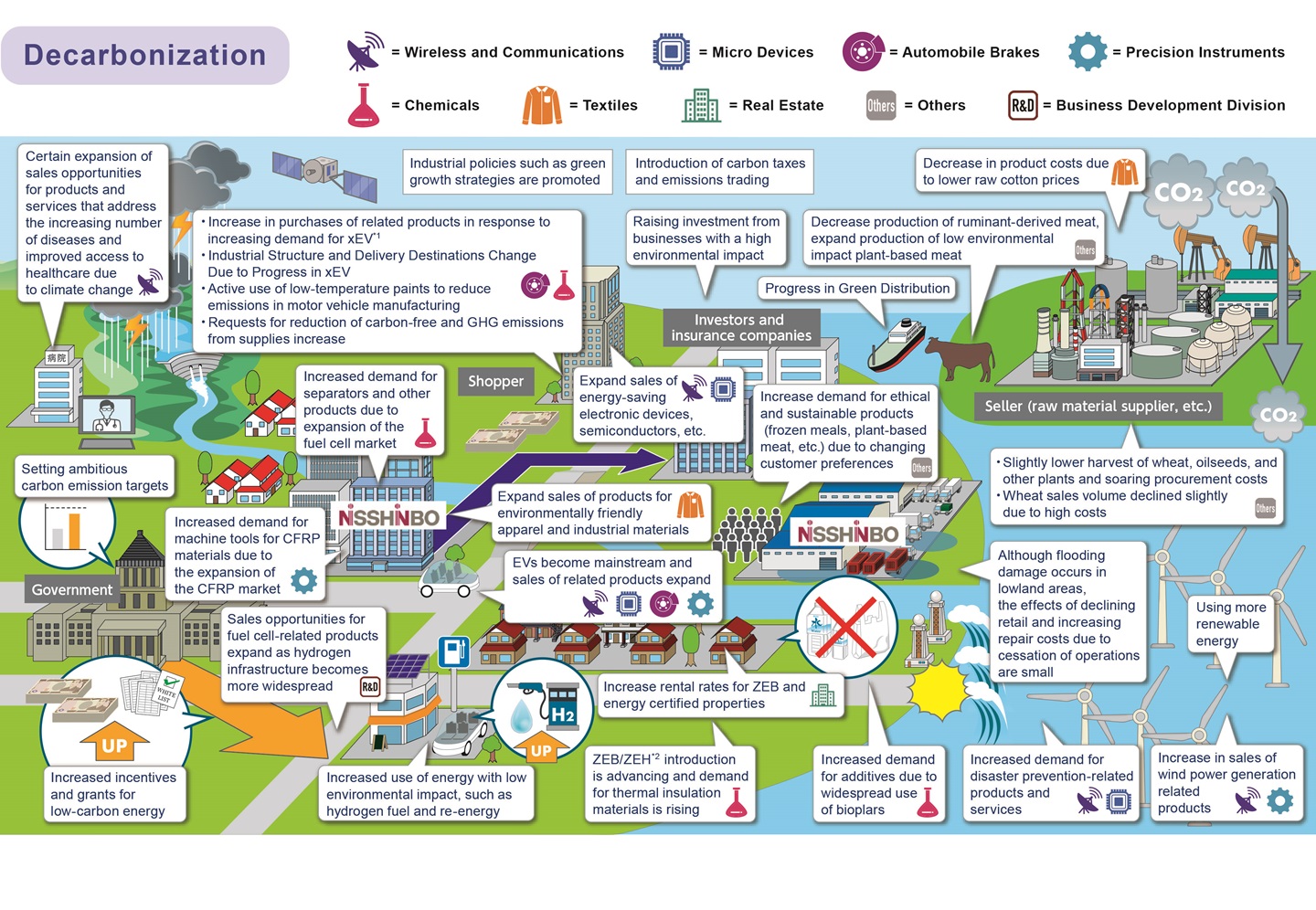
*1 xEV: Electric Vehicle (electric cars)
*2 ZEH/ZEH: Net Zero Energy House / Net Zero Energy House
3. Evaluate Business Impacts
In the scenario analysis, the Nisshinbo Group evaluated the financial impact by business segment. The following is a summary of the impact on the Nisshinbo Group as a whole by scenario.
- ・Under the global warming progression scenario and while insurance coverage has minimized the impact, a certain amount of cost increases will be required to deal with property damage from flooding, sales of products related to EVs, new energy vehicles, smart mobility, and fuel cells, as well as friction materials for brakes, are expected to increase.
- ・In the decarbonization scenario and while the challenge will be to reduce carbon tax costs, sales of EVs, new energy vehicles, smart mobility, and fuel cell-related products are expected to increase more than in the global warming scenario, and sales of decarbonization-related products and environmentally friendly products are expected to expand, including increased sales of insulation materials due to the spread of ZEB/ZEH.
- ・In both scenarios, the Business Development Division is expected to see significant potential opportunities, such as increased sales opportunities for fuel cell-related products, driven by the widespread use of hydrogen infrastructure.
The results of the impact assessment for each business segment are as follows:
In Solutions Business in the Wireless and Communication business, although there are differences in scale perceptions, demand for disaster prevention products and services is expected to grow in all possible scenarios in line with the increase in damage from natural disasters, such as floods. In the Marine System, ICT/Mechanics, and Mobility business, demand for EV and ship-related products is expected to increase in both scenarios, although there are differences in scale perceptions. In the Medical Equipment business, demand for products that respond to changes in disease associated with climate change is expected to grow under the global warming scenario. In addition, the development of products and services for telemedicine and other applications is expected to provide significant opportunities under both scenarios.
In the Micro Devices business, demand for EV-related products is expected to expand under both scenarios, and demand for water level gauge sensors is expected to increase in response to flood damage. In addition, under the decarbonization scenario, the response to the reduction of carbon tax costs will become an important issue in the future.
In both scenarios, the Automobile Brakes business is expected to increase demand for friction materials for brake assemblies with increasing demand for motor vehicles, but in the decarbonization scenario, the increase in demand for friction materials for braking replacements is expected to be limited by the prolongation of friction materials due to the widespread use of EVs. In addition, the scenario contains increased risks because future carbon regulations will be a factor in the reduction of benefits; therefore, decarbonization-related responses will be an important issue in the future.
In the Precision Instruments business, demand for wind power generation-related components and machine tools for CFRP* materials is expected to increase under both scenarios. In addition, under the decarbonization scenario, a response will be required in order to reduce carbon tax costs.
In the Chemicals business, increased sales of separators are expected to provide potentially significant opportunities in both scenarios from the proliferation of fuel cells. In addition, in the decarbonization scenario, the popularization of ZEB/ZEH is expected to increase the demand for insulation materials for building materials, increase the demand for additives as demand for bioplastics expand, and the demand for cross-linking agents will also increase from the expanded use of cold-drying paints.
In the Textiles business, the decarbonization scenario will require measures to address the significant impact of carbon taxes, while demand for environmentally friendly products is expected to grow, requiring the capture of demand for industrial materials and environmentally oriented apparel.
In the Real Estate business, physical damage to rental properties and other assets due to flooding is limited in both scenarios. In addition, rents are expected to increase for environmentally friendly properties in the decarbonization scenario.
In the Other business, although raw material costs for wheat and fats and oils will increase in both scenarios, the impact will be limited because of changes in sales strategies, and demand for environmentally friendly products in frozen meals and plant-based meat is expected to increase.
In the Business Development Division, both scenarios are expected to offer potentially significant opportunities for increased sales of fuel cell-related products, driven by the spread of hydrogen infrastructure, and capturing demand is required.
* CFRP: Carbon Fiber Reinforced Plastics
|
|
|
|
|
|
|
|
|
|
|
|
||
|
|
|
|
|
|
|
|
|
|
|
|
|
|
|
| Category | Assessment Item | Assessment of Impacts*1 | |
|---|---|---|---|
| Warming Progression Scenario | Decarbonization Scenario | ||
| Carbon price |
Increased cost of procuring raw materials from suppliers and manufacturing costs at factories due to carbon
taxation
|

|
 |
| Energy mix |
Increase in energy costs due to fluctuations in city gas, crude oil, and electricity prices
|

|
 |
| Customer and market changes |
Increase in sales for related products due to increased demand for marine transportation as a result of
modal shift
|
 |
 |
|
Increase in energy costs due to response to GHG reduction requests from customers
|
 |
 |
|
|
Increase in sales of brake friction materials due to change in demand for automobiles
|
 |
 |
|
|
Increase in sales of insulation materials due to the popularization of ZEB/ZEH
|
 |
 |
|
|
Increase in sales of cross-linking agents due to rising demand for cold-drying paints
|
 |
 |
|
|
Increase in sales of machine tools for CFRP materials due to an increase in the number of companies working
to reduce GHG emissions
|
 |
 |
|
|
Expand sales of other environmentally oriented and environmentally friendly products and services
(Increase
sales of products for environment-oriented apparel and environmentally friendly industrial materials, frozen
meals, plant-based meat to reduce food loss, and implement higher rents for properties with ZEB and energy
certifications)
|

|

|
|
| Spread of low-carbon and energy-saving technologies |
Increase in sales for products related to EVs, new energy vehicles, smart mobility, and fuel cells
|
 |
 |
|
Increase in sales of energy-saving GaN power semiconductors and electronic device related products
|
 |
 |
|
|
Increase in sales of wind power generation related parts
|
 |
 |
|
|
Increase in sales of related parts due to change in demand for ICE vehicles
|
 |
 |
|
|
Increase sales opportunities for fuel cell-related products as hydrogen infrastructure becomes more
widespread
|
 *2 *2 |
 *2 *2 |
|
| Average temperature rise, and Change in Precipitation and Weather patterns |
Increase in sales for disaster prevention products and services due to increased flood risk
|
 |
 |
|
Increase in sales for air conditioner parts due to more frequent use of air conditioning in summer
|
 |
 |
|
|
Decrease in product costs due to lower raw cotton prices
|
 |
 |
|
|
Decrease in profit due to higher purchase price costs resulting from lower yields of wheat and oilseeds;
increase in profit due to change in sales strategy
|
 |
 |
|
|
Increase in sales of clothing for heat protection
|
 |
 |
|
|
Expand opportunities to market products and services that address long-term changes in disease structure and
access to healthcare due to climate change
|
 *3 *3 |
 *3 *3 |
|
| Severity of extreme weather events |
Increased costs due to physical damage and loss of business interruption caused by flooding
|
 |

|
| *1 | Assessment of Impacts | : |
 :Positive
Impact/ :Positive
Impact/
 :Negative Impact :Negative Impact
|
| Degree of Impacts | : |
Less than 1 billion yen:
 / /
 ,
More than 1 billion yen but less than 5 billion yen: ,
More than 1 billion yen but less than 5 billion yen:
 / /
 , ,More than 5 billion yen but less than 10 billion yen:  / /
 ,
10 billion yen or more: ,
10 billion yen or more:
 / /

|
|
| (The size of the impact after taking into account the currently assumed countermeasures is described) | |||
| *2 | The size of the impact of the Business Development Division may fluctuate because of future business development and uncertainties of the information and data used. | ||
| *3 | The magnitude of the impact of the Medical Equipment business is targeted at products and services related to analyzers for the increasing number of diseases associated with climate change, telemedicine and medical big data, but the scale of the business may fluctuate because of future business development and uncertainties of the information and data used. | ||
4. Identify Potential Responses
In the future, based on the results of the scenario analysis, all business divisions will minimize risks related to greenhouse gas emissions while focusing on capturing the actual and potential opportunities related to the products and services of each business division in the medium to long term. The Nisshinbo Group has completed scenario analysis for its major businesses in FY2023 and will continue to revise the content as appropriate based on changes in the business environment.
| Business | Outline of Business Impacts | Direction of Responses |
|---|---|---|
| Common to all projects |
|
|

|
|
|
 |
|
|
 |
|
|
 |
|
|
 |
|
|
 |
|
|
 |
|
|
 |
|
|
 |
|
|
Risk Management
The Nisshinbo Group has established and operates a risk management system to appropriately respond to management risks of business and to minimize losses in the event of management risks. With regard to the risks and opportunities related to climate change that the Group should be aware of, the Nisshinbo Group will primarily identify, analyze, and evaluate the risks in each business segment based on the "Risk Management Regulations." Each business segment director will prioritize the risks and assume the magnitude of impact on the business under future scenarios. The Corporate Strategy Center is responsible for the overall mapping of this data, which is then discussed in the Board of Management and the Board of Directors.
Risk Management System
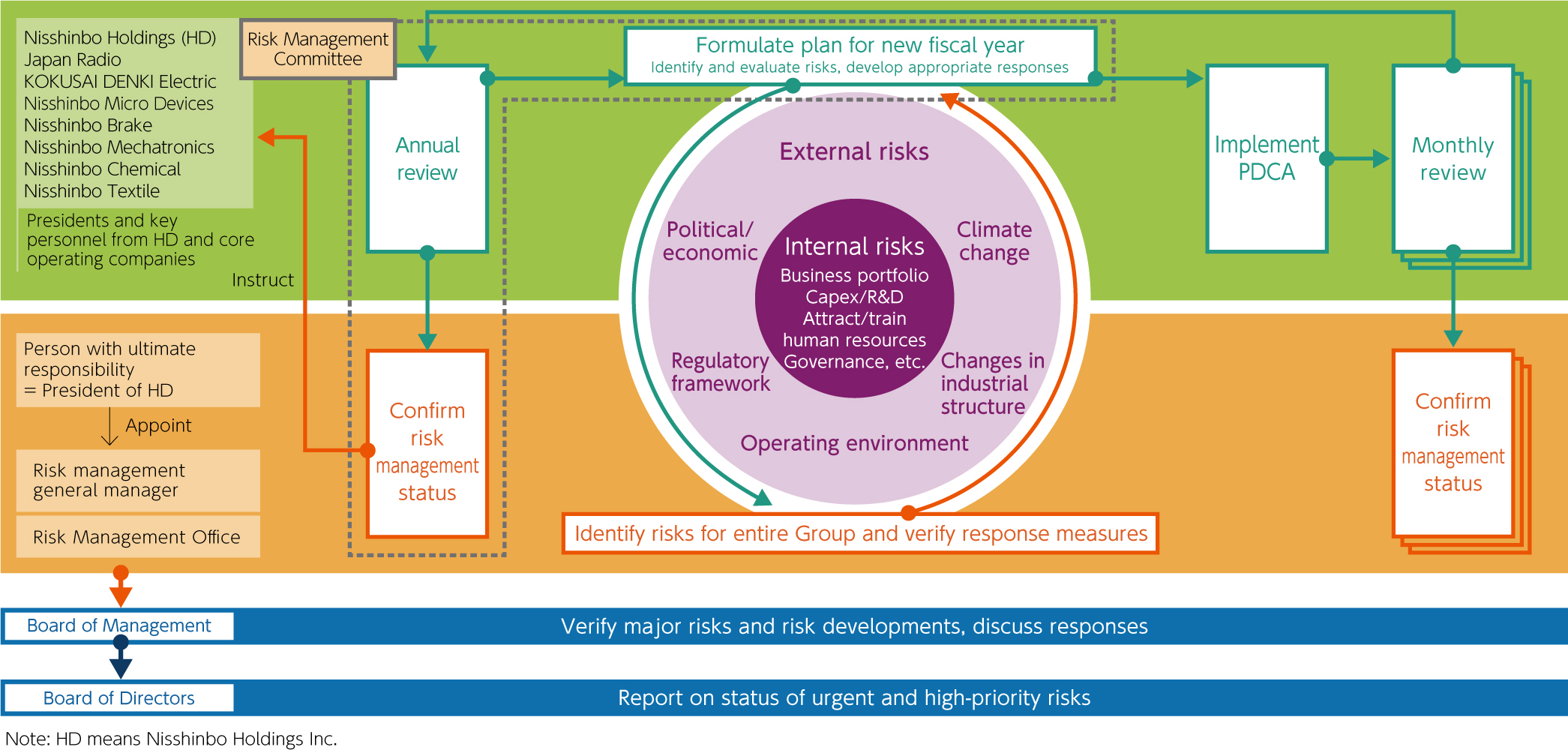
Risks and opportunities are assessed on a five-point scale based on the probability of occurrence and the degree of influence. Items whose products are more than constant are identified as important risks.
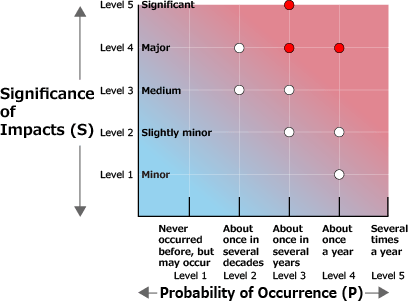
Taking into account the economic impact of identified risks, the Nisshinbo Group strives to respond by category to any of the four types of risk that can be avoided, mitigated, transferred, and held.
Risk Analysis Steps
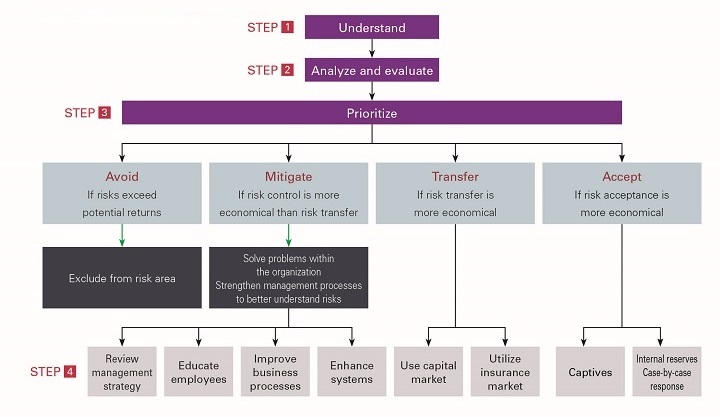
The details of the risks and opportunities that the Group perceives as having the potential to have an important impact on the linkage performance and response can be found on the "Risk Management" page.
Metrics and Targets
The Nisshinbo Group aims to capture climate change-related business opportunities and reduce risks. To reduce climate-related risks, the Nisshinbo Group actively promotes climate change measures, such as reducing energy conservation activities and PFCs (perfluorocarbons)* emissions with the aim of carbon neutrality by 2050.
* PFCs (perfluorocarbons): Fluorinated greenhouse gases used in dry etching and other processes in semiconductor
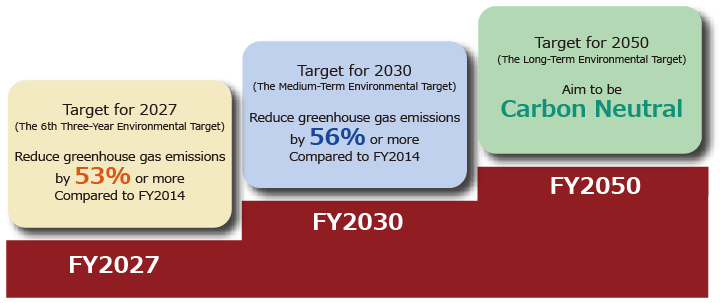
The business activities and environmental impact of the Group can be found in the "Material Balance" section.

